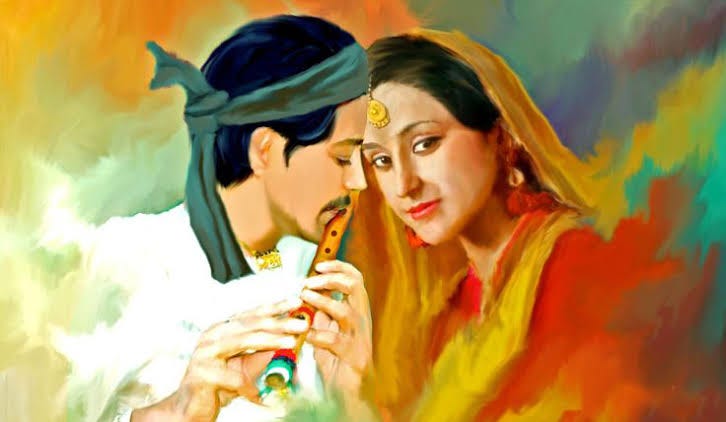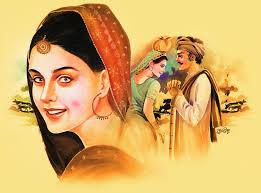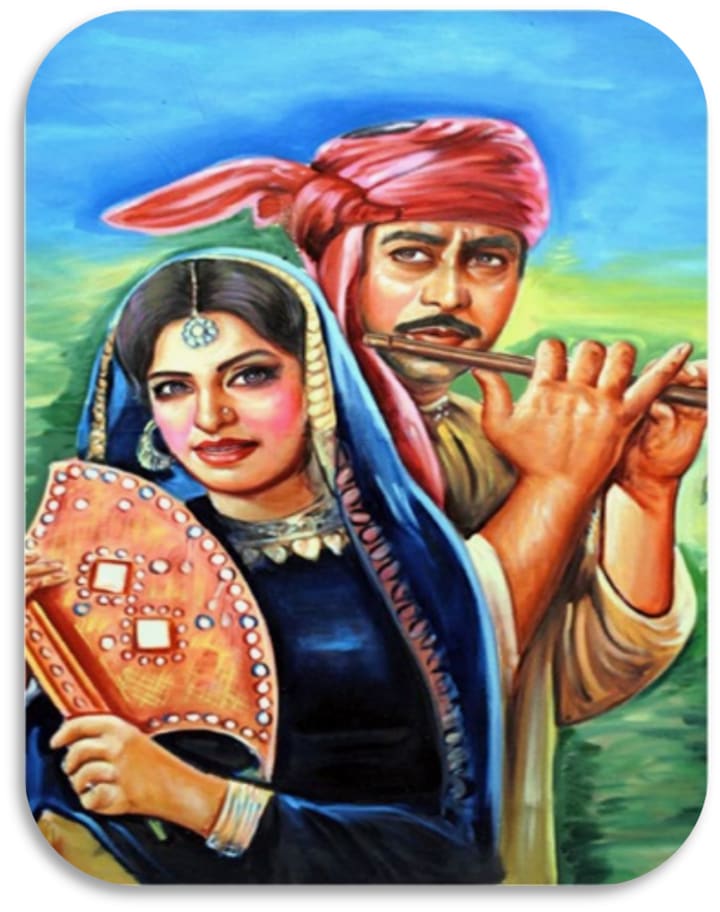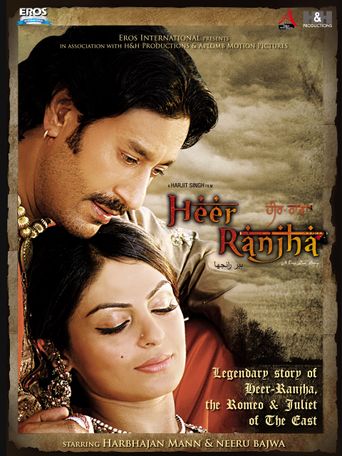Story of Heer Ranjha
Love That Still Stays

Heer Ranjha is a legendary folk tale of love and tragedy in the area of Jhang, Punjab in Pakistan.
Before We get started on Heer Ranjha ...
In the first place it is important to understand that many folk tales in the world including this one may not be hundred percent true and many may be a part of fiction.
The folk tale of Heer Ranjha has been transferred orally through the local cultures and was not written and documented by any of the leading historians by validating any data.
However, these folk tales are told by later writers, poets and sages.
The most famous version of Heer Ranjha tale is found in the writings of Warris Shah with his Poem on Heer Ranjha in 1766 AD.
How it Started - The Tale of Heer Ranjha

The legendary folk tale of Heer Ranjha is one of the most celebrated love stories from the Punjab region, which now is a part of Pakistan after partition between Pakistan and India.
This actual tale, dates back to the 15th century and has been passed down through generations through oral traditions, poetry, and literature, most notably through the poetic rendition by Waris Shah in 1766.
Early Lives and Backgrounds
Heer (actual name Izzat Bibi) was a daughter of a wealthy Sial family of Jhang (in present-day Pakistan), headed by her father Chuchak Sial, a powerful landlord of the region.
Her mother, Malki, was known for her strong personality and adherence to tribal traditions.
Heer grew up as a stunning beauty, educated in the traditional ways of her time, and was known for her sharp intellect and strong will.
The Sials were one of the most influential families in the region, known for their wealth, power, and strict adherence to tribal customs.
Ranjha (actual name Mian Umar) was called as Deedho Ranjha. He was the youngest of eight brothers in a family of Ranjha Jats from the village of Takht Hazara, by the banks of the river Chenab.
(At few places it is also mentioned that they were four brothers)
His father, Mauju Chaudhry, was a wealthy landlord.
Ranjha was the youngest son and he was pampered and grew up learning to play the flute (bansuri) rather than engaging in agricultural work like his brothers.
The First Heer Ranjha Meeting
After the death of his father, Ranjha faced hostility from his brothers and their wives over property distribution. Disillusioned, he left his village and wandered until he reached Jhang.
Fate brought him to the lands owned by Heer's father, where he was hired as a cowherd. This is where the legendary love story of Heer Ranjha began.
Heer was mesmerized by Ranjha's flute playing. The melodious tunes that emanated from his flute captured her heart.
According to the legend, when Heer first heard Ranjha's flute, she said, "Mein vi Ranjhe di, Ranjha mera" (I belong to Ranjha, and Ranjha belongs to me).
Their love blossomed as they spent time together in the fields, with Ranjha's music serving as their language of love.
The Love Story Unfolds

Over some period of time, their love for each other grew stronger with each passing day, but they had to meet in secret as such relationships were forbidden in their society.
Heer would bring food for Ranjha to the fields, and they would spend hours together, sharing their thoughts and dreams. Their pure love transcended physical attraction; it was a union of souls.
However, their secret meetings couldn't remain hidden forever. Village gossip reached Heer's parents, who were outraged.
The idea of their daughter being in love with a mere cowherd was unacceptable to the prestigious Sial family.
Despite Heer's protests and emotional pleas, her parents arranged her marriage to Saida Khera, a wealthy man from another village.
The Separation
Heer was forcibly married to Saida Khera, while Ranjha, heartbroken, left Jhang and became a Jogi (ascetic) under the guidance of Gorakhnath.
He renounced worldly pleasures and wandered from place to place, playing his flute and singing songs of separation from his beloved Heer.
Meanwhile, Heer lived a life of misery in her new home. She refused to accept her marriage and maintained her love for Ranjha.
When Ranjha learned of her whereabouts, he visited her village disguised as a Jogi. The lovers managed to meet and planned to elope.
The Tragic End
Different versions of the story offer different endings of Heer Ranjha.
In the most popular version, when Heer and Ranjha finally received permission to marry after many trials and tribulations, Heer's uncle Kaido, who had always opposed their union, poisoned her on the day of their wedding.
Upon learning of Heer's death, Ranjha rushed to her side and, unable to live without her, ate the same poison and died by her side.
In some other versions of the same folk tale, they both survived and lived happily later, though this version was very less common and hardly availble.
Historical Perspectives
Historians and scholars have different views about the historical authenticity of the Heer Ranjha tale.
Some key perspectives include:
1. Historical Reality: Some historians believe that Heer and Ranjha were real historical figures who lived in the 15th century in Punjab. They point to the existence of their alleged graves in Jhang as evidence. The tomb of Heer Ranjha in Jhang remains a popular pilgrimage site to this day.
2. Cultural Symbolism: Other scholars view the story as a symbolic representation of divine love, similar to other Sufi tales of the region. They interpret Heer and Ranjha's love as a metaphor for the soul's longing for divine union.
3. Social Commentary: Many historians see the tale as a criticism of the rigid social structures and class divisions of medieval Punjab. The story challenges traditional norms by presenting a love that transcends social boundaries.
4. Literary Evolution: Scholars trace how the story evolved through various retellings, with Waris Shah's version being the most celebrated. His poem not only tells the love story but also provides detailed insights into the social, cultural, and economic life of 18th-century Punjab.
Cultural Impact
 Movie Poster on Heer Ranjha
Movie Poster on Heer RanjhaThe tale of Heer Ranjha has had a profound impact on Punjab's cultural landscape:
1. Literature: The story has inspired countless poems, plays, and novels in various languages.
2. Cinema: Multiple films have been made on the story in both Pakistan and India.
3. Music: The tale has influenced folk music, with many songs based on their love story.
4. Language: Phrases from the story have become part of everyday Punjabi language.
Modern Interpretations
Contemporary scholars often analyze the folk tale through various lenses:
1. Feminist Perspective: Heer is seen as an early feminist character who defied local cultural norms to follow her heart.
2. Social Justice: The story is interpreted as a critique of class discrimination and social inequality.
3. Religious Harmony: Some see it as a tale promoting religious harmony, as love transcends religious boundaries.
Wrap Up & Lasting Legacy
The tale of Heer Ranjha continues to resonate with audiences today because it addresses universal themes:
1. The power of true love
2. The conflict between individual desire and societal expectations
3. The struggle against social injustice
4. The price of following one's heart
The story has become a cultural touchstone, representing the richness of Punjab's literary and cultural heritage.
It serves as a reminder of how love can challenge social norms and inspire generations to question unjust traditions.
The tale of Heer Ranjha remains one of the most significant contributions to South Asian literature and culture.
Whether viewed as historical fact, or just a piece of fiction, or a combination of both, its impact on the cultural impact still remains.
The story continues to inspire new interpretations and retellings, proving that its themes of love, sacrifice, and social justice remain relevant in the modern world.
You may also read more about Heer Ranjha here.
You May Read More History Stories at IdeasBeat
New! Comments
Have your say about what you just read! Leave me a comment in the box below.